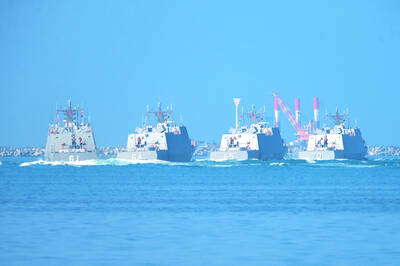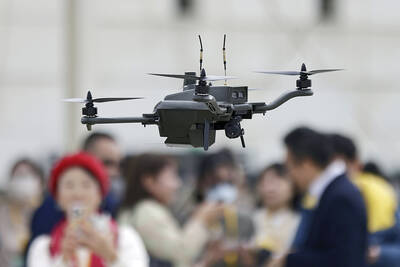Despite sabotage, looting and other setbacks, Iraq began pumping crude oil from its northern oil fields on Wednesday to export facilities in Turkey for the first time since the war.
Analysts said it was unclear how reliable the flow of oil from fields near the city of Kirkuk might prove to be, but the renewed use of the pipeline to Ceyhan, Turkey, marked a milestone in the restoration of Iraq's oil industry and augured well for thirsty world markets.
Iraq began pumping oil from its northern oil fields at around 4:30pm, a Turkish oil official at the Ceyhan terminal said, speaking on condition of anonymity.
Turkey's semiofficial Anatolia news agency quoted Energy Ministry officials as saying the first Iraqi oil reached the Mediterranean port at 9:30pm.
"In a couple of weeks, you should be able to start inviting tankers to come on down," said Peter Gignoux, head of the petroleum desk at Salomon Smith Barney in London.
Iraq sits atop the world's second-largest proven crude reserves, and oil exports are vital to its postwar reconstruction and the success of US efforts to implant democracy in the country.
Before the war halted Iraq's oil production, the country pumped around 2.1 million barrels a day, most of it for export.
However, it managed to export a paltry 300,000 barrels a day last month, said Michael Rothman, chief energy strategist at Merrill Lynch in New York.
"The reality is that the export program has been stymied by unfortunate but continuing acts of sabotage. This is still the issue," Rothman said.
Iraqi Oil Ministry officials could not immediately confirm that crude was flowing into the pipeline.
Iraq began exporting from its giant southern oil fields last month, sending fresh crude to ships waiting offshore in the Gulf at the export terminal of Mina el-Bakr. These southern exports have been intermittent, due to power outages at the terminal and other interruptions.
Although Iraq's big northern fields also resumed production after the US-British invasion, crude from the north was unavailable for export until now. Saboteurs and looters dogged efforts to rehabilitate the 950km pipeline from Kirkuk to Ceyhan. The lack of storage and export facilities forced the Iraqis to reinject much of the northern crude left over after refining for domestic use back into the natural underground reservoirs.
"Our problem was not with the production of oil but with the security of the pipeline. It was really mainly sabotage. That is all. Otherwise we could have continued exporting crude oil in sizable quantities," said an official at Iraq's State Oil Marketing Organization, which controls Iraqi oil exports.
The official spoke from Baghdad on condition of anonymity.
Iraq was expected to pump between 300,000 and 400,000 barrels a day to Ceyhan. No oil tankers are currently booked to load there, and oil was expected to flow for about 10 days before any vessels would be sent for loading.
"We have to wait for the storage tanks to be filled before exports can begin," the Turkish official said.
Ceyhan already holds about 500,000 barrels of Iraqi crude in storage and has room for around 7.5 million more barrels. Turkish energy officials said Iraq previously stopped pumping crude to Ceyhan on March 23.
The pipeline from Kirkuk is actually two parallel lines, one of which hasn't been used for years. The operable pipeline has a capacity of about 1 million barrels a day.
"It had been unclear whether oil would be flowing through there at all. Without it, you were bottling up half of Iraq's export capacity," said Jan Stuart, head of energy research at FIMAT USA, the New York brokerage unit of Societe Generale.
Delays in Iraqi exports have helped lift US oil prices to well above US$30 per barrel. Despite historically low inventories of crude in major importing countries, OPEC members agreed on July 31 to keep output steady -- a decision that provided no comfort to consumers.
"At the end of the day, the oil coming out of Iraq is something the market needs right now," Rothman said.
Iraq's oil exports resumed after the UN Security Council lifted sanctions on Iraq in May and recognized the US-led coalition's authority over the country and its oil revenue.

FOUR DESIGNATED AREAS: Notices were issued for live-fire exercises in waters south and northwest of Penghu, northeast of Keelung and west of Kaohsiung, they said The military is planning three major annual exercises across the army, navy and air force this month, with the navy’s “Hai Chiang” (海強, “Sea Strong”) drills running from today through Friday, the Ministry of National Defense said yesterday. The Hai Chiang exercise, which is to take place in waters surrounding Taiwan, would feature P-3C Orion maritime patrol aircraft and S-70C anti-submarine helicopters, the ministry said, adding that the drills aim to bolster the nation’s offshore defensive capabilities. China has intensified military and psychological pressure against Taiwan, repeatedly sending warplanes and vessels into areas near the nation’s air defense identification zone and across

FORCED LABOR: A US court listed three Taiwanese and nine firms based in Taiwan in its indictment, with eight of the companies registered at the same address Nine companies registered in Taiwan, as well as three Taiwanese, on Tuesday were named by the US Department of the Treasury’s Office of Foreign Assets Control (OFAC) as Specially Designated Nationals (SDNs) as a result of a US federal court indictment. The indictment unsealed at the federal court in Brooklyn, New York, said that Chen Zhi (陳志), a dual Cambodian-British national, is being indicted for fraud conspiracy, money laundering and overseeing Prince Holding Group’s forced-labor scam camps in Cambodia. At its peak, the company allegedly made US$30 million per day, court documents showed. The US government has seized Chen’s noncustodial wallet, which contains

SUPPLY CHAIN: Taiwan’s advantages in the drone industry include rapid production capacity that is independent of Chinese-made parts, the economic ministry said The Executive Yuan yesterday approved plans to invest NT$44.2 billion (US$1.44 billion) into domestic production of uncrewed aerial vehicles over the next six years, bringing Taiwan’s output value to more than NT$40 billion by 2030 and making the nation Asia’s democratic hub for the drone supply chain. The proposed budget has NT$33.8 billion in new allocations and NT$10.43 billion in existing funds, the Ministry of Economic Affairs said. Under the new development program, the public sector would purchase nearly 100,000 drones, of which 50,898 would be for civil and government use, while 48,750 would be for national defense, it said. The Ministry of

SENATE RECOMMENDATION: The National Defense Authorization Act encourages the US secretary of defense to invite Taiwan’s navy to participate in the exercises in Hawaii The US Senate on Thursday last week passed the National Defense Authorization Act (NDAA) for Fiscal Year 2026, which strongly encourages the US secretary of defense to invite Taiwan’s naval forces to participate in the Rim of the Pacific (RIMPAC) exercise, as well as allocating military aid of US$1 billion for Taiwan. The bill, which authorizes appropriations for the military activities of the US Department of Defense, military construction and other purposes, passed with 77 votes in support and 20 against. While the NDAA authorizes about US$925 billion of defense spending, the Central News Agency yesterday reported that an aide of US